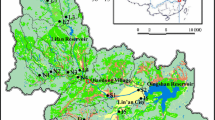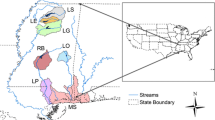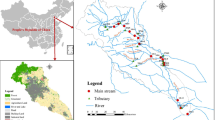Abstract
Different land uses of upstream catchments may affect the quantity and the quality of dissolved organic matter (DOM) in watersheds, but the influence may differ by season. In this study, we examined concentrations and selected spectroscopic properties of DOM and the propensity to form trihalomethanes (THMs) for 19 different middle-sized watersheds across the Han River basin in Korea. Sampling was conducted for non-storm events during pre-monsoon (May) and monsoon seasons (July). The anthropogenic land uses including agricultural and residential areas occupied 2.3 to 49.4 % of the upstream catchments of the watersheds. Non-aromatic, labile, and less condensed DOM structures were more abundant in the monsoon season. Parallel factor analysis (PARAFAC) modeling with fluorescence data demonstrated that a combination of three different fluorescence components could explain the seasonal and the spatial distributions of DOM characteristics. Terrestrial humic-like fluorescence was the most abundant component for all the DOM samples, while protein-like fluorescence became more pronounced for the monsoon season. THM concentrations did not differ between the two seasons. Observed seasonal differences in the concentrations and the characteristics of DOM suggested a greater contribution of groundwater to the streams in watersheds in the monsoon versus the pre-monsoon season. Significant correlations among anthropogenic land use, microbial humic-like fluorescence, and the propensity to form THMs were found only for the pre-monsoon season. Principal component analysis (PCA) demonstrated that, regardless of the season, anthropogenic land uses increased the concentrations of DOM and nutrients but that their effects on the DOM properties were not evident for the monsoon season.






Similar content being viewed by others
References
APHA (American Public Health Association), AWWA (American Water Works Association), WEF (Water Environment Federation) (2005) Standard methods for the examination of water and wastewater, 20th edn. Washington DC, USA
Beggs KMH, Summers RS (2011) Character and chlorine reactivity of dissolved organic matter from a mountain pine beetle impacted watershed. Environ Sci Technol 45:5717–5724
Bond T, Goslan EH, Parsons SA, Jefferson B (2010) Disinfection by-product formation of natural organic matter surrogates and treatment by coagulation, MIEX (R) and nanofiltration. Water Res 44:1645–1653
Chang H (2008) Spatial analysis of water quality trends in the Han River basin, South Korea. Water Res 42:3285–3304
Chen W, Westerhoff P, Leenheer JA, Booksh K (2003) Fluorescence excitation-emission matrix regional integration to quantify spectra for dissolved organic matter. Environ Sci Technol 37:5701–5710
Chow AT, Gao S, Dahlgren RA (2005) Physical and chemical fractionation of dissolved organic matter and trihalomethane precursors: A review. J Water Supply Res T 54:475–507
Coble PG (2007) Marine optical biogeochemistry: the chemistry of ocean color. Chem Rev 107:402–418
Crosbie RS, McCallum JL, Walker GR, Chiew FHS (2010) Modelling climate-change impacts on groundwater recharge in the Murray-Darling Basin, Australia. Hydrogeol J 18:1639–1656
Fellman JB, Hood E, Edwards RT (2009) Changes in the concentration, biodegradability, and fluorescent properties of dissolved organic matter during stormflows in coastal temperate watersheds. J Geophys Res 114, G01021
Fellman JB, Hood E, Spencer RGM (2010) Fluorescence spectroscopy opens new windows into dissolved organic matter dynamics in freshwater ecosystems: a review. Limnol Oceanogr 55:2452–2462
Fuentes M, Baigorri R, Gonzalez-Gaitano G, Garcia-Mina JM (2007) The complementary use of H-1 NMR, C-13 NMR, FTIR and size exclusion chromatography to investigate the principal structural changes associated with composting of organic materials with diverse origin. Org Geochem 38:2012–2023
Graeber D, Gelbrecht J, Pusch MT, Anlanger C, Schiller D (2012) Agriculture has changed the amount and composition of dissolved organic matter in Central European headwater streams. Sci Total Environ 438:435–446
Hua G, Reckhow DA (2007) Characterization of disinfection byproduct precursors based on hydrophobicity and molecular size. Environ Sci Technol 41:3309–3315
Hua B, Veum K, Yang J, Jones J, Deng B (2010) Parallel factor analysis of fluorescence EEM spectra to identify THM precursors in lake waters. Environ Monit Assess 161:71–81
Huguet A, Vacher L, Relexans S, Saubusse S, Froidefond JM, Parlanti E (2009) Properties of fluorescent dissolved organic matter in the Gironde Estuary. Org Geochem 40:706–719
Hur J, Schlautman MA (2003) Molecular weight fractionation of humic substances by adsorption onto minerals. J Colloid Interface Sci 264:313–321
Hur J, Hwang SJ, Shin JK (2008) Using synchronous fluorescence technique as a water quality monitoring tool for an urban river. Water Air Soil Pollut 191:231–243
Inamdar S, Finger N, Singh S, Mitchell M, Levia D, Bais H, Scott D, McHale P (2012) Dissolved organic matter (DOM) concentration and quality in a forested mid-Atlantic watershed, USA. Biogeochemistry 108:55–76
Jaffé R, Boyer JN, Lu X, Maie N, Yang C, Scully NM, Mock S (2004) Source characterization of dissolved organic matter in a subtropical mangrove-dominated estuary by fluorescence analysis. Mar Chem 84:195–210
Maie N, Scully NM, Pisani O, Jaffé R (2007) Composition of a protein-like fluorophore of dissolved organic matter in coastal wetland and estuarine ecosystems. Water Res 41:563–570
McKnight DM, Boyer EW, Westerhoff PK, Doran PT, Kulbe T, Andersen DT (2001) Spectrofluorometric characterization of dissolved organic matter for indication of precursor organic material and aromaticity. Limnol Oceanogr 46:38–48
O’Donnell JA, Aiken GR, Kane ES, Jones JB (2010) Source water controls on the character and origin of dissolved organic matter in streams of the Yukon River basin, Alaska. J Geophys Res- Biogeosci 115, G03025
Pifer AD, Fairey JL (2012a) Improving on SUVA254 using fluorescence-PARAFAC analysis and asymmetric flow-field flow fractionation for assessing disinfection byproduct formation and control. Water Res 46:2927–2936
Pifer AD, Fairey JL (2012b) Improving on SUVA254 using fluorescence-PARAFAC analysis and asymmetric flow-field flow fractionation for assessing disinfection byproduct formation and control. Water Res 46:2927–2936
Soulsby C, Gibbins C, Wade AJ, Smart R, Helliwell R (2002) Water quality in the Scottish uplands: a hydrological perspective on catchment hydrochemistry. Sci Total Environ 294:73–94
Stedmon CA, Markager S (2005) Tracing the production and degradation of autochthonous fractions of dissolved organic matter by fluorescence analysis. Limnol Oceanogr 50:1415–1426
Vidon P, Hubbard LE, Soyeuk E (2009) Seasonal solute dynamics across land uses during storms in glaciated landscape of the US Midwest. J Hydrol 376:34–47
Wickland KP, Aiken GR, Butler K, Dornblaser MM, Spencer RGM, Striegl RG (2012) Biodegradability of dissolved organic carbon in the Yukon River and its tributaries: seasonality and importance of inorganic nitrogen. Global Biogeochem Cy 26:GB0E03
Williams CJ, Yamashita Y, Wilson HF, Jaffé R, Xenopoulos MA (2010) Unraveling the role of land use and microbial activity in shaping dissolved organic matter characteristics in stream ecosystems. Limnol Oceanogr 55:1159–1171
Wilson HF, Xwnopoulos MA (2009) Effects of agricultural land use on the composition of fluvial dissolved organic matter. Nat Geosci 2:37–41
Yamashita Y, Jaffé R, Maie N, Tanoue E (2008) Assessing the dynamics of dissolved organic matter (DOM) in coastal environments by excitation emission matrix fluorescence and parallel factor analysis (EEM-PARAFAC). Limnol Oceanogr 53:1900–1908
Yamashita Y, Kloeppel BD, Knoepp J, Zausen GL, Jaffé R (2011) Effects of watershed history on dissolved organic matter characteristics in headwater streams. Ecosystems 14:1110–1122
Yang L, Hong H, Guo W, Huang J, Li Q, Yu X (2012) Effects of changing land use on dissolved organic matter in a subtropical river watershed, southeast China. Reg Environ Chang 12:145–151
Zhang Y, van Dijk MA, Liu M, Zhu G, Qin B (2009) The contribution of phytoplankton degradation to chromophoric dissolved organic matter (CDOM) in eutrophic shallow lakes: field and experimental evidence. Water Res 43:4685–4697
Zsolnay A, Baigar E, Jimenez M, Steinweg B, Saccomandi F (1999) Differentiating with fluorescence spectroscopy the sources of dissolved organic matter in soils subjected to drying. Chemosphere 38:45–50
Acknowledgments
This work was supported by a National Research Foundation of Korea Grant funded by the Korean Government (MEST) (NRF-2011-0029028).
Author information
Authors and Affiliations
Corresponding author
Additional information
Responsible editor: Céline Guéguen
Rights and permissions
About this article
Cite this article
Hur, J., Nguyen, H.VM. & Lee, BM. Influence of upstream land use on dissolved organic matter and trihalomethane formation potential in watersheds for two different seasons. Environ Sci Pollut Res 21, 7489–7500 (2014). https://doi.org/10.1007/s11356-014-2667-4
Received:
Accepted:
Published:
Issue Date:
DOI: https://doi.org/10.1007/s11356-014-2667-4




